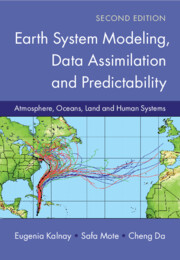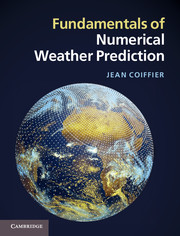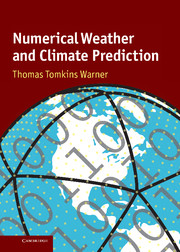Earth System Modeling, Data Assimilation and Predictability
Since the publication of the first edition of this highly regarded textbook, the value of data assimilation has become widely recognized across the Earth sciences and beyond. Data assimilation methods are now being applied to many areas of prediction and forecasting, including extreme weather events, wildfires, infectious disease epidemics, and economic modeling. This second edition provides a broad introduction to applications across the Earth systems and coupled Earth–human systems, with an expanded range of topics covering the latest developments of variational, ensemble, and hybrid data assimilation methods. New toy models and intermediate-complexity atmospheric general circulation models provide hands-on engagement with key concepts in numerical weather prediction, data assimilation, and predictability. The inclusion of computational projects, exercises, lecture notes, teaching slides, and sample exams makes this textbook an indispensable and practical resource for advanced undergraduate and graduate students, researchers, and practitioners who work in weather forecasting and climate prediction.
- Unifies the inherently connected subjects of Earth System modelling, data assimilation, and predictability in a unique way
- Includes sections on the intermediate global primitive equations model SPEEDY as an introduction to the dynamical core and physical parameterizations of a full spectral Earth System Model
- Discusses the development of coupled Earth–Human System modelling and how to use data assimilation to estimate parameters, constrain uncertainties, and improve predictions with these models
- Provides a suite of supplementary online resources to help facilitate teaching and learning
- The author team is led by world-leading authority on atmospheric data assimilation, Eugenia Kalnay
Reviews & endorsements
‘The first edition is a classic, the definitive text on the subject written by an essential contributor to data assimilation theory and to operational weather forecasting. The second edition is better: broader, expanding to earth system models, and deeper, including the advances of the past decades, right up to machine learning. The presentation is honed by decades of teaching this material, making complex topics clear. The inclusion of models with two-way coupling between the human and climate systems opens a new research direction. The methodology of combining models and data is broadly applicable beyond climate science and this is the place to learn it. This is one of the few science texts that is a great book.’ Mark Cane, Emeritus, Lamont-Doherty Earth Observatory of Columbia University
‘Since first publication 22 years ago by the world’s preeminent expert on data assimilation, modelling and prediction of weather and climate have evolved from atmospheric models to complex earth system models with interactions between the atmosphere, biosphere, and hydrosphere. This second edition is an indispensable update, at just the right time for students, researchers, and practitioners. It introduces readers to the emerging field of interactions between earth and human systems - an understanding of which is critical for the sustainability of human societies.’ Jagadish Shukla, Center for Ocean-Land-Atmosphere Studies, George Mason University
Review of previous edition: ‘… a frisson of excitement accompanied the rumour that Eugenia Kalnay was writing a new book. Expectations were high, since she is a renowned expert in the field. She has not disappointed us.’ Science and Technology
Review of previous edition: ‘… quite wonderful, achieving a tremendous balance between comprehensiveness and readability. I am especially pleased with the numerical analysis part, which is crystal clear and shows the benefits of classroom testing. I also like the tiny little touches, like the stepped-on butterfly story and the mention that Poincaré knew about chaos in celestial mechanics. Your book fills an enormous hole in the literature of NWP [numerical weather prediction].’ Richard C. J. Somerville, Scripps Institution of Oceanography, San Diego
Review of previous edition: ‘Fantastic … in content, format and practicability.’ Kelvin K. Droegemeier, Regents’ Professor of Meteorology, and Director, Center for Analysis and Prediction of Storms, University of Oklahoma
Review of previous edition: ‘I admire the clarity and pedagogic superiority of [this] presentation.’ Anders Persson, Swedish Meteorological and Hydrological Institute (SMHI)
Review of previous edition: ‘… much better for learning about data assimilation than anything else currently available.’ Richard Swinbank, United Kingdom Meteorological Office
Review of previous edition: ‘… the presentation is impeccable and is very accessible to non-meteorologists like me.’ Eric Kostelich, University of Arizona
Review of previous edition: ‘… what a great wealth of historical information.’ Lawrence Takacs, NASA, Data Assimilation Office
Review of previous edition: ‘… a delight to read … It will be of great assistance to our community and should greatly encourage young scientists who may be thinking of entering the field … the book will be of considerable value to people who are unable or unwilling to cope with mathematical technicalities. They can gain much by studying the expository sections of the text.’ Peter Lynch, Assistant Director, Irish Weather Service
Review of previous edition: ‘… the method in the data assimilation section of starting with ‘baby’ examples, and then working up through the full analysis, is great for understanding. On the predictability part, the history, and the explanations of how the unstable perturbations grow is the best I’ve seen.’ Alexander E. MacDonald, Director, NOAA Forecast Systems Lab
Review of previous edition: ‘… this book … is extremely useful, informative, and well-written … there are many instances where items that were only marginally familiar beforehand have now become very clear.’ Brian O. Blanton, Senior Scientist/Oceanographer, University of North Carolina, Chapel Hill
Product details
October 2024Paperback
9781107401464
372 pages
243 × 169 × 20 mm
0.64kg
Available
Table of Contents
- Dedication
- Preface to the Second Edition
- Reviews and Comments on the First Edition
- Foreword to the first edition
- Acknowledgement in the First Edition
- List of Variables
- List of Abbreviations
- 1. An overview of numerical weather prediction
- 2. The continuous equations
- 3. Numerical discretization of the equations of motion
- 4. Introduction to the parameterization of subgrid-scale physical processes
- 5. Data assimilation
- 6. Atmospheric predictability and ensemble forecasting
- A. Coding and checking the tangent linear and the adjoint models
- B. Post-processing of numerical model output to obtain station weather fore-casts.







